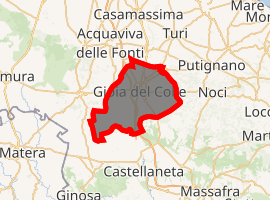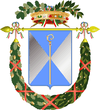Gioia del Colle
Gioia del Colle (pronounced [ˈdʒɔːja del ˈkɔlle]; Barese: Sciò) is a town and comune of the Metropolitan City of Bari, Apulia, southern Italy. The town is located on the Murge plateau at 360 metres (1,180 ft) above sea level. Between Adriatic and Ionian Sea.
Gioia del Colle | |
|---|---|
| Comune di Gioia del Colle | |
Location of Gioia del Colle 
| |
 Gioia del Colle Location of Gioia del Colle in Italy  Gioia del Colle Gioia del Colle (Apulia) | |
| Coordinates: 40°48′N 16°56′E | |
| Country | Italy |
| Region | |
| Metropolitan city | Bari (BA) |
| Frazioni | Colonia Hanseniana, Corvello, La Torre, Casino Eramo e Marzagaglia, Monte Sannace, Montursi, Murgia, Santa Candida, Terzi, Villaggio Azzurro |
| Government | |
| • Mayor | Donato Lucilla |
| Area | |
| • Total | 206.48 km2 (79.72 sq mi) |
| Elevation | 360 m (1,180 ft) |
| Population (1 January 2015)[2] | |
| • Total | 27,923 |
| • Density | 140/km2 (350/sq mi) |
| Demonym(s) | Gioiesi |
| Time zone | UTC+1 (CET) |
| • Summer (DST) | UTC+2 (CEST) |
| Postal code | 70023 |
| Dialing code | 080 |
| ISTAT code | 072021 |
| Patron saint | Saint Philip Neri |
| Saint day | 26 May |
| Website | Official website |
History
The earliest evidence of human settlement in the area now known as Gioia del Colle dates back to the 9th century BC. Archaeological excavations have revealed that at that time a Peucetian village was located in the area of Monte Sannace, about 5 kilometres (3 mi) from Gioia). Monte Sannace site, 5 km away from the town in the direction of Turi, has been the subject of archaeological excavations since 1957 by the Superintendency of Antiquities in Apulia and Matera. The excavations, completed in 1961, have brought to light a settlement of the ancient Peucetian village dating back to the 9th century BC and which continues, with brief interruptions, until the Hellenistic-Roman period (approximately until the first century AD). The archaeological park includes some sections of the defensive circuits and the north gate, in addition to a good part of the town, numerous tombs and several buildings of the acropolis. The archaeological area is located at 4.5 kilometres from the provincial road "Gioia del Colle - Turi" (SP 61). The finds from the excavations are preserved in the National Archaeological Museum located inside the Norman-Swabian Castle.
The current town developed around an old Byzantine fortress. The placename, in fact, seems to derive from Joha, short for the surname Joannakis, a Byzantine family living in the area during the Middle Ages. However, there are many theories regarding the origin of this placename. One of the most famous local legends has it that Princess Bianca Lancia irretrievably lost all her jewels there, after being supposedly confined in the Castle of Gioia del Colle during her pregnancy with her son Manfred of Sicily under the suspicion of having been unfaithful to Frederick II.
The town grew further in the 12th century, during the time of Norman Count Richard of Hauteville, who built the castle. In the 13th century the fief was under the rule of Frederick II of Swabia, who rebuilt the castle.
Gioia del Colle was part of the principality of Taranto and a fief of the princes De Mari of Acquaviva delle Fonti until the abolition of feudalism.
Main sights
Castle
The Castle of Gioia del Colle was built in the 12th century, during the time of Norman Count Riccardo Siniscalco d'Altavilla, the first tenant of the fief. Destroyed by William I of Sicily, the castle was rebuilt in 1230 by Emperor Frederick II after his return from the Crusades. The castle was then completed by the Angevins, who created windows in the curtain wall.
According to Bonaventura da Lama (who quoted the historian Pantaleo) Bianca Lancia was confined in this castle while pregnant with Manfred of Sicily, on suspicion of having been unfaithful to Frederick II. In fact, on the wall of a cell (which is likely to have been the princess') are carved shapes, which, according to a local legend, are intended to represent her breasts, which she cut off in pain at being so humiliated. After giving birth, she sent the alleged illegitimate child to the emperor on a silver platter together with her breasts.
The later owners between 1600 and 1800 (the Acquaviva d'Aragona family, the De Mari and Donna Maria Emanuela Caracciolo) changed the castle appearance into a residential one.
Others sights
- Mother church (chiesa madre), built in the late 11th century and initially dedicated to St. Peter. In 1764 it was destroyed by a fire, and rebuilt in the current Baroque style.
- Arches in the historical center.
- Boschi Romanazzi, a natural preserve managed by WWF Italia.
Economy
The economy of Gioia del Colle is centred on agriculture, dairy farming and commerce. The town is famous for its Fior di latte mozzarella and its Gioia del Colle Primitivo wine.
Red, white, rose, sweet dolce and fortified liquoroso wines are permitted in the Italian wine DOC of the area. Red and rose wine grapes are limited to a harvest yield of 12 tonnes/ha while white wine grapes are limited to a yield of 13 tonnes/ha. The reds and roses are a blend of 50-60% Primitivo, a 40-50% blend component of Montepulciano, Sangiovese, Negroamaro and Malvasia (with Malvasia being further limited to a 10% maximum). The whites are composed of 50-70% Trebbiano with other permitted local grape varieties, such as Pampanuto, making up the remainder. A varietal Primitivo wine is permitted, provided the wine is 100% composed of the grape with yields limited to 8 tonnes/ha and a minimum alcohol level of 13%. The dolce wine of the area is composed of at least 85% Aleatico with a 15% maximum blend component of Malvasia, Negroamaro and Primitivo making up the rest. The grapes must also be limited to a harvest yield of 8 tonnes/ha and have a minimum alcohol level of 15%. The liquoroso version must have a minimum alcohol of 18.5%.[3]
Culture
Cinema
In addition to being the birthplace of Ricciotto Canudo, who fuelled the debate about the art of the cinema during his stay in Paris, Gioia del Colle has been the location of filming of three films, in different periods:
- Some scenes of Idillio Infranto (1931), a silent film directed by Milanese Nello Mauri, were shot in the town centre and in the countryside of Gioia del Colle.
- The Castle of Gioia del Colle was the set for some scenes of Il Vangelo secondo Matteo (1964) by Pier Paolo Pasolini.
- Terra bruciata (1999), the debut film of director Fabio Segatori starring Raoul Bova, Giancarlo Giannini, Michele Placido and Bianca Guaccero, was set in Goia del Colle.[4]
Music
The Banda di Gioia del Colle directed by Maestro Paolo Falcicchio has won prestigious awards throughout Italy, such as the Venice International Competition in 1924 and the Professional Competition in Rome in 1929.
Gioia del Colle was the birthplace of the well-known band Il Fungo Cinese (1967), which accompanied artists such as Patty Pravo, Caterina Caselli and Jimmy Fontana.
Mario Rosini came from Gioia del Colle, finishing second at the Sanremo festival in 2004 with the song Sei la vita mia.
Two bands from Gioia del Colle have trod the stage of the Sziget Festival in Budapest: C.F.F. e il Nomade Venerabile (2005), The Carving (2006).
The documentary on the history of music by Gioia del Colle Rockerella has been available on YouTube since 2017.
Events
- International theater festival Teatro Lab 2.0 - Chièdiscena, April - May
- Feast of Saint Joseph the Worker in Montursi, 1 May
- Feast of the patron saint Philip Neri, 26 May
- Feast of Saint Vitus the Martyr, 15 June
- Feast of Saint Roch, 16 August
- Celebration of the mozzarella, August
- Celebration of the new wine, September
- Feast of the Pupo Fritto in Montursi, September
- Feast of Saint Lucy, 13 December
People

- Gigi Angelillo, actor.
- Ricciotto Canudo, intellectual and theorist of the cinema.
- Nicola Legrottaglie, Italian association football player.
- Maurizio Vasco, author and journalist, living in New York City.
- Bob Pisani, journalist CNBC, whose grandfather was from Gioia del Colle
- Sylvester Stallone, actor, whose father was born in Gioia del Colle before emigrating to the United States and grandfather of Dark Seba
- Sergeant Romano, of the Bourbon army. (it.)
- Sebastiano Cantore, actor and character of TV Series "Sebian"
Transportation
Gioia del Colle Air Base hosts the 36th Italian Air Force Wing.
Trivia
- The song L'onorevole Bricolle by Clara Jaione (1948), which Claudio Villa later famously interpreted,[5] is about the wry story of a fictitious "Honorable Bricolle, a Member of Parliament from Gioia del Colle".
Twin towns
References
- "Superficie di Comuni Province e Regioni italiane al 9 ottobre 2011". Istat. Retrieved 16 March 2019.
- Population from ISTAT
- P. Saunders Wine Label Language pg 167 Firefly Books 2004 ISBN 1-55297-720-X
- Alfonso Marrese. Apulia Film Commission.
- ironic video of the historical interpretation of Claudio Villa (YouTube)
